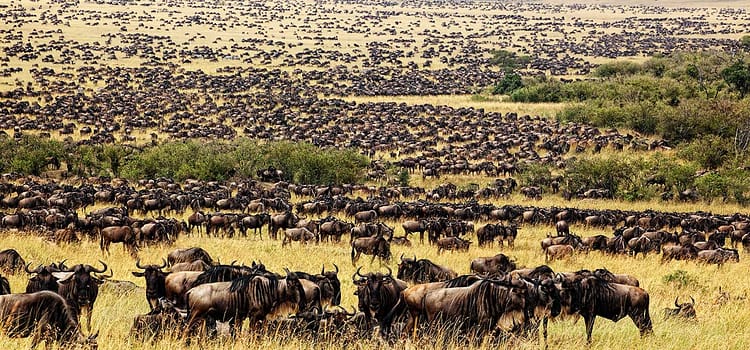Our short report on how the wildebeest migration pattern between Serengeti and Masai Mara was like from May to September 2021
The migration of almost 2 million wildebeests, Zebras and Topis between the Serengeti and Masai Mara Eco system is without doubt the world’s most spectacular wildebeest spectacle. The highlights of this never-ending wildebeest journey are the annual calving season in the short grass plains of southern Serengeti between February and March and the mass movements and River crossings between Serengeti and Masai Mara from July to October.
This year, the wildebeest migration has lived up to its thrill once again.
The main motivation for the mass movement covering thousands of Kilometers is search for food and water. With scattered rains having fallen both on Serengeti and Masai Mara throughout the year, it means that there has been enough pasture in both parks. The wildebeests were therefore not in hurry to arrive in Masai Mara since there was adequate pasture in Serengeti.
From May, thousands of wildebeests could be sighted headed for Western Serengeti, from where they proceeded to the Grumeti, Fort Ikoma and Ikorongo areas before settling in Kogatende in northern Serengeti. From June, the scouts (mainly Zebras and small herds of Topis and Wildebeests) begun arriving in Masai Mara.
By mid-July, a good number of the migrant herds had already crossed over to Kenya. Big herds could be seen around the Sand River and central Masai Mara. Daily River Crossings were been recorded at the Looking Out Mara River Crossing points and the main crossing near Purrungat bridge as the marauding Gnus and Zebras made that dive of life or death heading towards the Mara Triangle or back to the main reserve.
On the other hand, big herds could still be sighted in Kogatende, northern Serengeti as they grazed or crossed the river several times, heading north or south. The ones that headed further north snaked their way to the amazingly beautiful Lamai Wedge where they spent several weeks grazing.
In early August, several big herds were congregated in central Masai Mara and predator vs prey action was in full swing as Lions and Cheetahs made daily kills. The famous Tano Bora Cheetah coalition (now 4 after they kicked one out of the group) could be seen by lucky tourists and guides as they made a kill every few hours. This was also reported among some Lion prides. By this time, Masai and northern Serengeti were full of wildebeest and Zebra carcass and Hyenas, Jackals and Vultures were having a field day enjoying plenty of food.
By mid-August, the wildebeests that had followed the Lamai Wedge route begin pushing further into the Mara Triangle. The most interesting part about this was that they went directly to the Triangle avowing the traditional route that would see them cross the Mara River inside the reserve. By end of August, the biggest part of the migrant herds was settled within the Mara Triangle with only a few scattered herds being reported in the main reserve.
Hundreds upon hundreds of thousands (probably up to a million) could be seen all the way from the Egyptian Goose dam extending all the way towards Baghdad Pond, Mara Serena Safari Lodge up to Kichwa Tembo road with views of congregated herds being witnessed right from the road side to kilometers far away, with the Oloololo escarpment in the horizon, forming the perfect background for captivating photo images.
The Masai Mara, currently enjoying unexpected rains and with its short grass plains full of juicy pasture, the herds that had made their way back towards Serengeti or even stayed there are being sighted headed back to Masai Mara as from late September. River crossings are being witnessed in northern Serengeti as several massive herds make a push towards the Masai Mara while others head the opposite direction into Serengeti.
It will be interesting to trail the migration and see how long they will stay in Masai Mara this year since the land of mottled plains is enjoying rains and has enough pasture, meaning that they might decide to stay until November, unless the Gnu instincts kick in and remind them that they need to rush and settle back in southern Serengeti on time for the calving season.
Stay tuned right here and on our FACEBOOK and INSTAGRAM pages for more updates from both the Serengeti and Masai Mara.
Feel free to contact us on: holidays@esseniasafaris.co.ke for a tailor made and privately guided Masai Mara and Serengeti Wildebeest Migration safari.


